Hat tip to Pete Struwe, 39 years later.
The word radical comes from the Latin root radix, which itself means root. Radix gives us radish, that root some of you like to eat. It gives us radical as in the mathematical symbol, √, which we use to signify that we are taking the square root of a number. It gives us eradicate—ex + radix + ate—which literally/etymologically means to tear out the roots, which we now use to mean to remove or destroy completely. Thus, a radical proposal completely uproots prior principles and practices. A radical person seeks to root out current beliefs and practices, overturn the status quo, and (except for the rare genuine anarchist) establish an entirely new order.
The second revision of South Dakota’s K-12 social studies curriculum standards is a radical proposal. Their author, Hillsdale College professor emeritus William Morrisey, is a radical, in that he proposes to tear out by the roots the approach to social studies that South Dakota’s K-12 teachers have developed and refined over decades of practice and replace it with an entirely new (mostly chronological and thus intellectually inferior) order.
The core of the current K-12 social studies standards, composed by South Dakota educators and adopted in 2015, consists of 23 anchor standards organized into the disciplines of history (5 anchor standards), civics (6), geography (7), and economics (5).
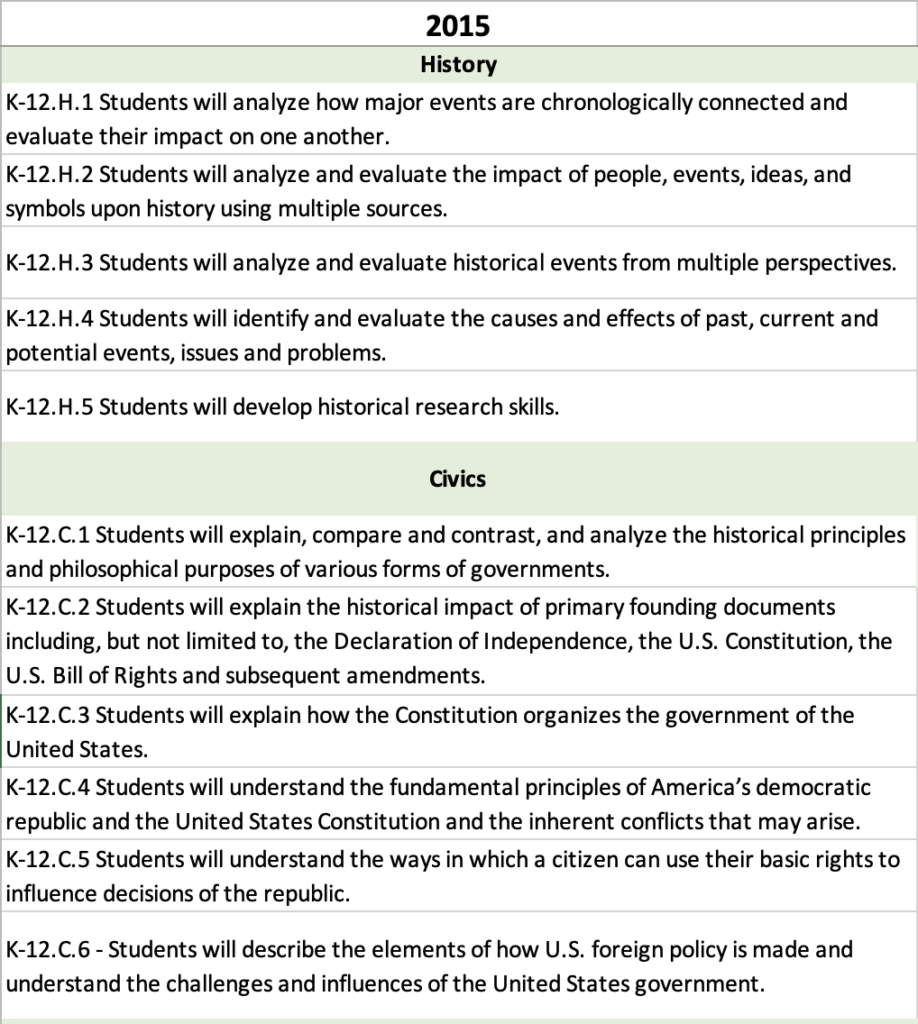
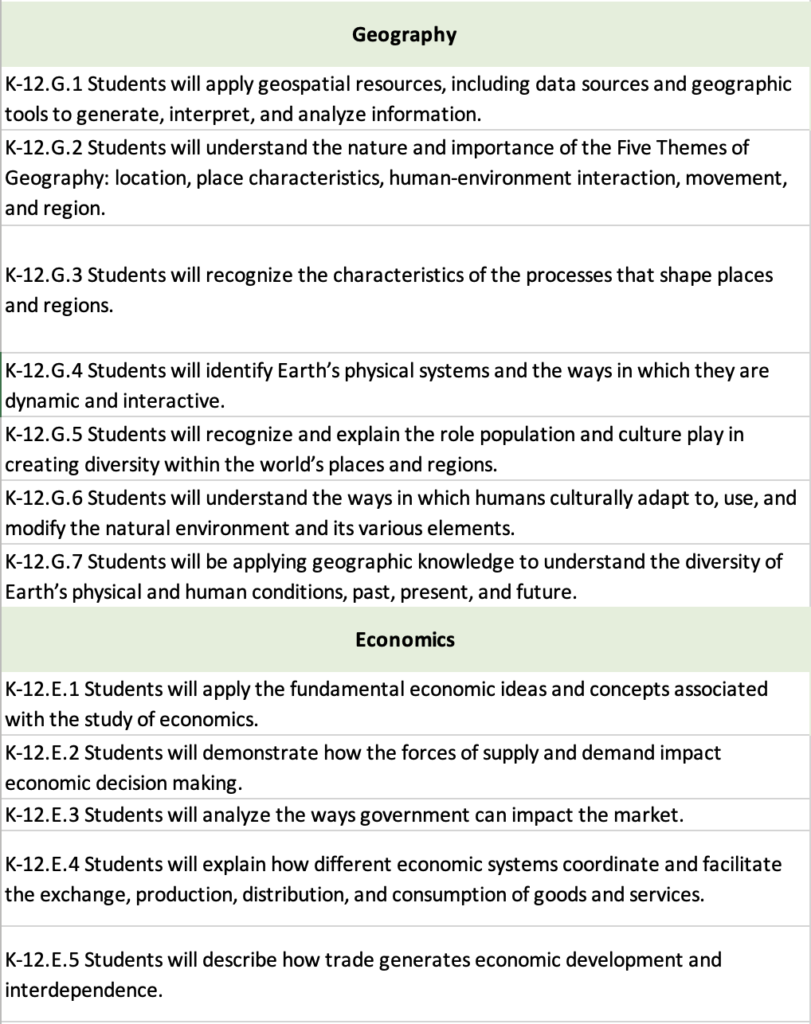
Each grade level has its own more specific standards (I’d call them substandards, but that would give folks the wrong idea; the 2015 document simply calls them grade-level standards) giving the topics and skills that elementary, middle school, and high school lessons will tackle. But all of those grade-level standards are tied back to an anchor standard. Whatever specifics they are working on, teachers can always point back to one of those few anchor standards to say, Here’s how this specific lesson fits into the big picture of this social studies discipline. Here’s how what we are teaching today aligns not just with the grade-level standard but with the fundamental skills of citizenship that we as a state, a broad community of professionals working together, believe every student in South Dakota needs to develop and deploy in civic life.
That’s what the anchor standards are: fundamental skills of citizenship, keys to informed participation in civic life.
The original workgroup of South Dakota educators that convened in 2021 to revise the K-12 social studies standards built on the 2015 anchor standards. Their July 2021 draft proposal (the one Governor Noem hijacked, then ashcanned to clear the decks for her desired revision) struck a couple anchor standards, added a couple, and revised many of the rest:

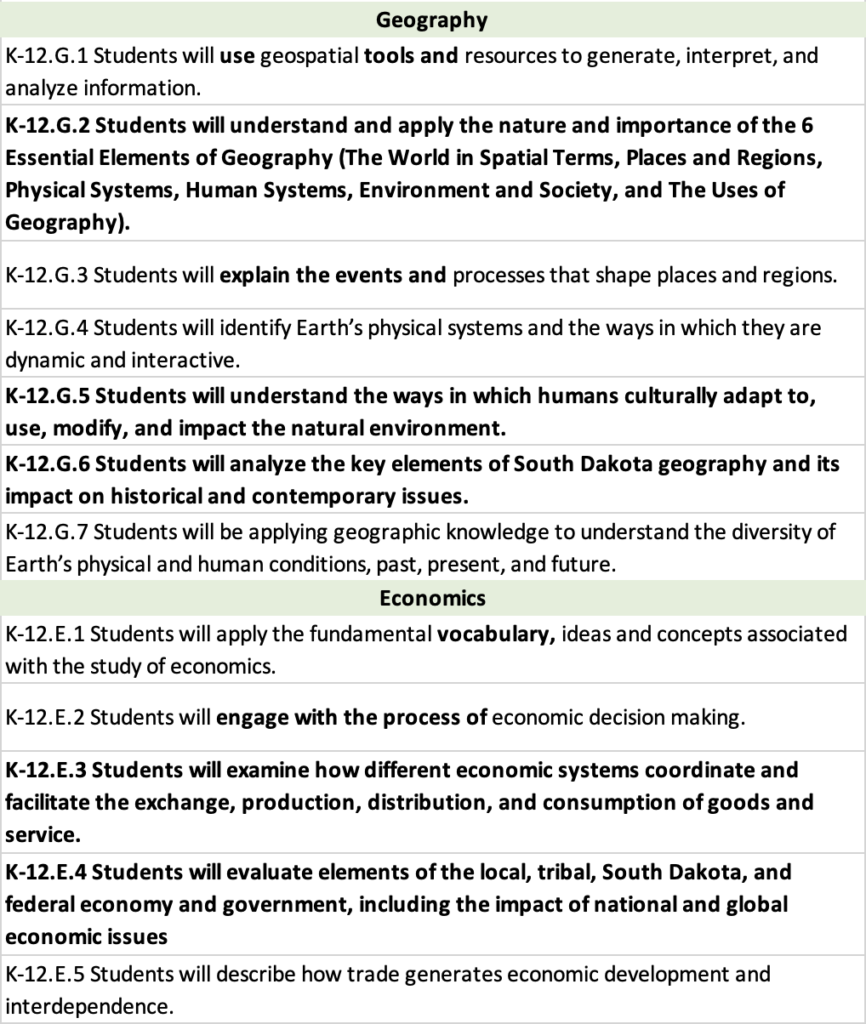
The 2021 draft offered some interesting changes and fine points of language that academics may discuss. Geography anchor standard 2 marks an evolution from Five Themes to Six Elements. Civics 4 and 5 and Economics 4 add explicit mention of tribal affairs. History 3 on analyzing and evaluating historical events from multiple perspectives changes to coach students to analyze the factors that shaped perspectives in different historical periods and spins off a new History 6 to incorporate multiple points of view in studying South Dakota history specifically.
Whatever these changes meant for practical lesson design and delivery, the 2021 workgroup preserved the concept and structure of the anchor standards. The 2021 workgroup preserved the idea of an underpinning framework of fundamental skills of citizenship that our social studies teachers have a duty to foster in every child at every step of their K-12 education.
The 2022 revision, the Hillsdale/Morrisey/Noem standards, throws those anchor standards out. The 2022 revision offers no new anchor standards to replace the old. The 2022 revision provides no outline of civic, intellectual skills to unify or justify each grade-level standard. The 2022 revision provides no underpinning framework of civic goals that tell kindergarten teachers why they are having the kids recite stories about Elijah McCoy, John Muir, or Clarence Thomas, that tell second-grade teachers and fourth-grade teachers why they are having the kids identify the historical events of the Carolingian dynasty, that tell the sixth-grade teachers why they are having kids explain Muslim architecture in the Middle Ages and the Concordat of Worms, or that tell high school economics teachers why they are having their students explain the American founders’ views on private property and how such explanation fits into the fundamental social studies skills the students have been learning throughout their K-12 education.
The 2022 revision paints a “spiraled sequence” onto these standards, but that “spiraled sequence” simply outlines the most general topics, by time and place:
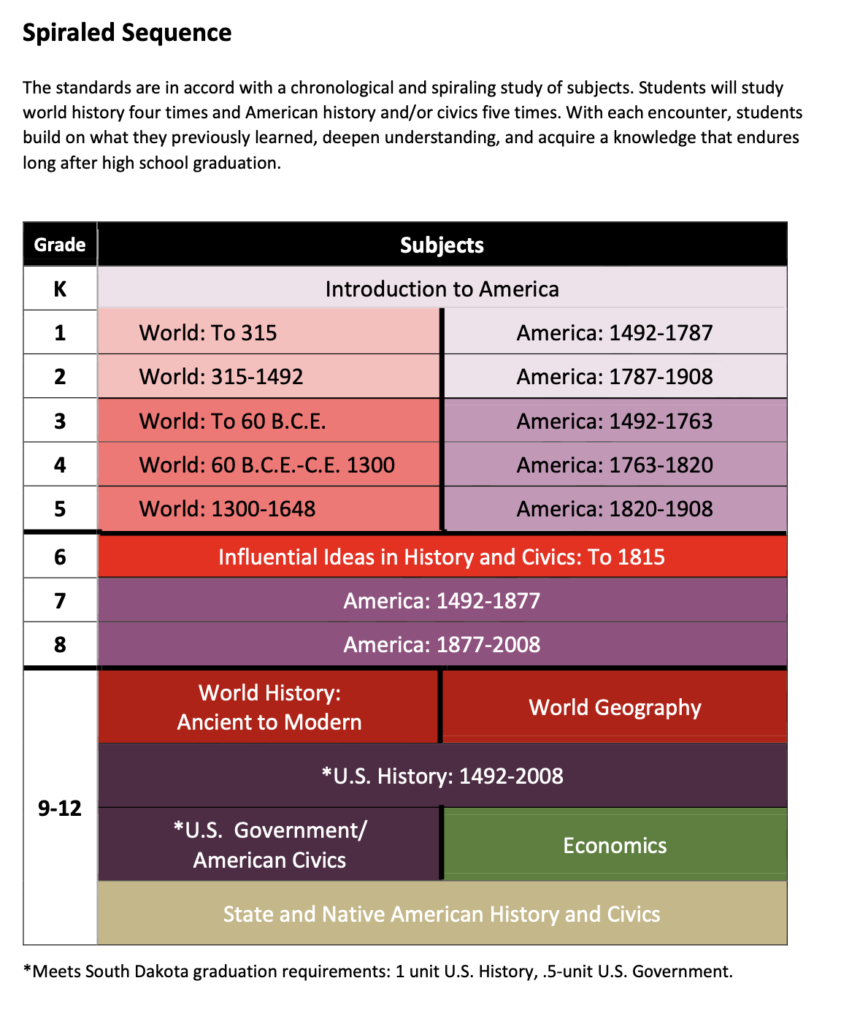
World. America. 1492–1787. 1492–1763. 1820–1908.
Unlike the anchor standards, this “spiraled sequence” provides no unity, no coherent skills or objectives. It doesn’t even provide complete sentences. It haphazardly labels the boxes into which it will stuff its parade of Trivial Pursuit cards that it expects teachers to pull and preach and students to memorize and recite.
* * *
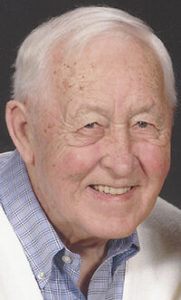
I had a jarring experience on my first day of seventh grade at Madison Junior High School. I took my seat in the front row of the social studies classroom commanded by Mr. Struwe—Merle “Pete” Struwe, who died last year at age 92, who was only a couple years older than I am now when he opened class that day in 1983 but who looked ancient to me on that first day of school in that august old three-story building in the center of Madison…I can only speculate that Mr. Struwe was born old.
Anyway, seventh grade, first day, Mr. Struwe is explaining what his class is about, and he singles me out. I do not remember the exact words, but he says, Cory Heidelberger here is really good at answering questions on Quickie Quiz.
KJAM had a call-in quiz game on the radio every morning at 7:55. When I didn’t have to ride the bus, when Mom or Dad would take us to school, I had time to listen to Dan Sudenga read off a trivia question (or maybe two, if he got an answer to the first one really fast before the 8 a.m. news). When Dan started the question, I’d dial the number on our yellow rotary phone—256-4514, and I think the strategy varied from dialing all the way in to grab a line to holding that last 4 on the hook, ready to release if I knew the answer. I got a lot of answers and won a lot of coupons—cones from Dairy Queen, treats from the Rexall Drug Store next to Ben Franklin right across Center Street from the radio station, tacos from the new Taco John’s… I ate like a king as a kid. I think there might have even been movie tickets to the West Twin Theatre. Oh, the free stuff a kid could get by being smart!
And it’s called Quiz Biz, by gum, not Quickie Quiz. I’m ready to correct Mr. Struwe, but before I can assert my freebie-winning intellectual ego, my new social studies teacher proceeds to plow my ego into the dirt:
Cory knows a lot of facts, but Cory doesn’t know concepts. And social studies is about concepts.
“Cory” and “doesn’t know” together in a sentence—those were fighting words to this 12-year-old. (They still kind of are, but now I have hyperlinks to back me up.) Mr. Struwe, in front of a whole bunch of my fellow seventh graders, including a bunch of kids from Lincoln and Garfield who didn’t know of my Washington Elementary report-card brilliance and who needed to be let know just how smart I was, had just belittled my claim to local cerebral celebrity and told those kids and me, to my face, that I didn’t know concepts, that I was, in an important way, as dumb as the rest of them.
Mr. Struwe didn’t like me. Mr. Struwe was picking on me. Mr. Struwe was a bad teacher. Or so I thought. So I’m sure I told Mom and Dad when I got home.
I was, of course, wrong. Mr. Struwe was a really good social studies teacher, and I was dumb, in many ways. I knew facts, but I didn’t know concepts. I could win Quiz Biz, but Quiz Biz wasn’t social studies. Quiz Biz wasn’t training for civic life.
And he wasn’t picking on me. He was uprooting a core piece of my childish identity, rooting out a misunderstanding, and replacing it with a more mature and useful principle.
Mr. Struwe was a radical. A good radical. Who’d’a’ thought?
* * *
I don’t know what the K-12 social studies standards looked like in 1983. I don’t know if we even had statewide standards then. But Mr. Struwe’s teaching had at least one anchor standard: teach kids concepts, not just facts. Our current social studies standards embody that idea: teach kids concepts, not just facts.
The revised social studies standards that Hillsdale and the Governor propose have no anchor standards. They only list facts.
I will not presume to put words in Mr. Struwe’s mouth. But from what he taught me, I understand that social studies should push students beyond trivial pursuits, to inquiry and critical thinking that will help them participate in and promote civic life. Hillsdale eradicates inquiry from social studies’ core—”Inquiry-based learning is a pedagogical approach that lies outside the scope of a standard,” writes Professor Morrisey—and instead preps kids for Quiz Biz… or nowadays, trivia night at the pub. The Hillsdale standards teach kids the opposite of what Mr. Struwe taught me on my first day at Madison Junior High.
The Hillsdale standards are radical. Bad radical. We should throw them out before they take root. We should restore and refine the current standards, as the apolitical 2021 workgroup did, and preserve the anchor standards, the framework of fundamental civic skills that unify and justify our K-12 social studies teaching.
Let’s stick with Mr. Struwe. Let’s stick with our roots.
Great post, Cory. Amen.
Wyoming is struggling with the Hillsdale radicalism, too.
https://cowboystatedaily.com/2022/09/06/proposed-wyoming-charter-schools-make-pitch-to-state-gov-says-dont-slam-public-schools/
Cory, you remind me of Jean Sheppard with such descriptions and humor!!!! Well done and lucky to have learned such a lesson on the first day.
I love the addition of k-12 G.6 in the 2021 draft with a focus on South Dakota.
Proud to be friends with many from the Struwe clan. Forward thinkers for the most part.
PS … MAGA’s eschew the Social Studies curriculum because their kids aren’t social, and their kids rarely study which is how MAGA’S want it.
Under subjects, we find grade 1 studying the world from ? to the common Era 315…that is the date of the Council of Nicacea, the first convocation of Christian Bishops which heatedly discussed whether Christ had two natures (God and Man) or one nature (he was composed of all God, and was something of a cosmic tourist during his time on Earth). Who knows how the first grade teacher will handle “the rise of man” or creation theory but when the 7 years olds master that they can move on to the Metaphysical argument that lasted over 400 years and led to a total bloodbath throughout the known world. See the book, “The Jesus Wars” by religious scholar Phillip Jenkins.
Council of Nicea was 325..conversion of the Roman Empire’s royal family to Christianity was approximately 315..you can’t discuss one without the other.
I find it a bit frightening to think that there is no “American” history prior to 1492. I guess life in the Western Hemisphere began with Columbus.
Great Job Cory,
Noem is a revisionist and promotes cancel culture.
V, that anchor standard on South Dakota embeds our state into the main principles of geography on which multiple lessons and units may be based. The Michigan/Hillsdale standards give South Dakota no such central place; South Dakota material is simply sprinkled through the grade-level standards as an add-on, always auxiliary/secondary to the prime focus on national geography, history, civics, and economics.
And Jean Sheppard—this Canadian writer?
DaveFN: Noem is certainly trying to cancel the good standards we have and the good revision our own social studies teachers produced for us last summer. I wonder if she’ll now try to cancel Rapid City social studies teacher and workgroup member Shaun Nielsen for voicing opposition to Hillsdale’s work.
SJF, the Michigan/Hillsdale standards do have grade-level standards in third grade, seventh grade, and high school that mention the Pueblo, Hopewell, Maya, and other Indigenous people pre-Columbus. But those mentions are no more central than the mentions of South Dakota and its Oceti Sakowin.
Cory, I taught geography not spelling OOPS. Jean Shepard who wrote “In God We Trust, All Others Pay Cash.”
Ah! Author Jean Shepherd, who inspired and narrated A Christmas Story. Thanks, V!
“Where there is no vision the people perish.” –Proverbs 29:18
I doubt Noem and her comrades would or can interpret that in any other way than to impose an ideological narrative on the masses as though it were the “vision” at stake: the United States as a result of the invisible hand of God, a kind of manifest destiny shaped by the divine into a Christian nation. With American exceptionalism thrown in.
If you can get hold of it, read philosopher Simon Gusman’s excellent “There Are No True Stories: Narrative identity and the Ambiguity of La Nausée as an Existentialist Novel,” in Clio 46: 3, 2017:
“Sartre’s view of literature when he was writing La Nausée is that the structure that can never be found in life itself can be found in literature, and that through writing adventure novels, one’s life can take on a semblance of the necessary structure that books have and, therefore, a meaning. …Roquentin hopes to find salvation in writing a novel,…”
Noem hopes to find salvation in imposing a Hillsdale narrative structure that can never existed in history, a tendentious, teleological narrative which amounts to political grooming of public school children meant to lead them to the inescapable conclusion that the US is a Christian nation founded on the Bible. And which ultimately justifies her existence and keeps her in office as savior of the masses.
I don’t see where the Hillsdale standards have anything to do with Michigan public schools. Below is the link to the schools under Hillsdale influence. Lots of Catholic schools and Protestant schools but no public schools. SD can be the first to ruin a new generation. WOW!
https://k12.hillsdale.edu/Schools/Affiliate-Classical-Schools/
“Salon investigates: The war on public schools is being fought from Hillsdale College”
March 16, 2022
https://www.salon.com/2022/03/16/salon-investigates-the-on-public-schools-is-being-fought-from-hillsdale-college/